Why should anyone know or talk about Cadron, a park site in Arkansas? Because it is actually very important for understanding the infamous Trail of Tears, as well as American history more broadly.
It was May 28, 1830 when the scandal-ridden outwardly racist serial liar President Jackson (who in fact owed his life to the Cherokee after the 1814 Battle of Horseshoe Bend) had the dishonor of signing into law the first significant piece of legislation in the US that required forced mass removal and displacement of Native Americans.
…Cherokee named Junaluska saved Jackson from an attacker, prompting the Tennessean to declare, “As long as the sun shines and the grass grows, there shall be friendship between us.” But in the peace treaty he negotiated with the Creeks, Jackson confiscated 23 million acres of land in Alabama and Georgia—some of which belonged to the Cherokees.
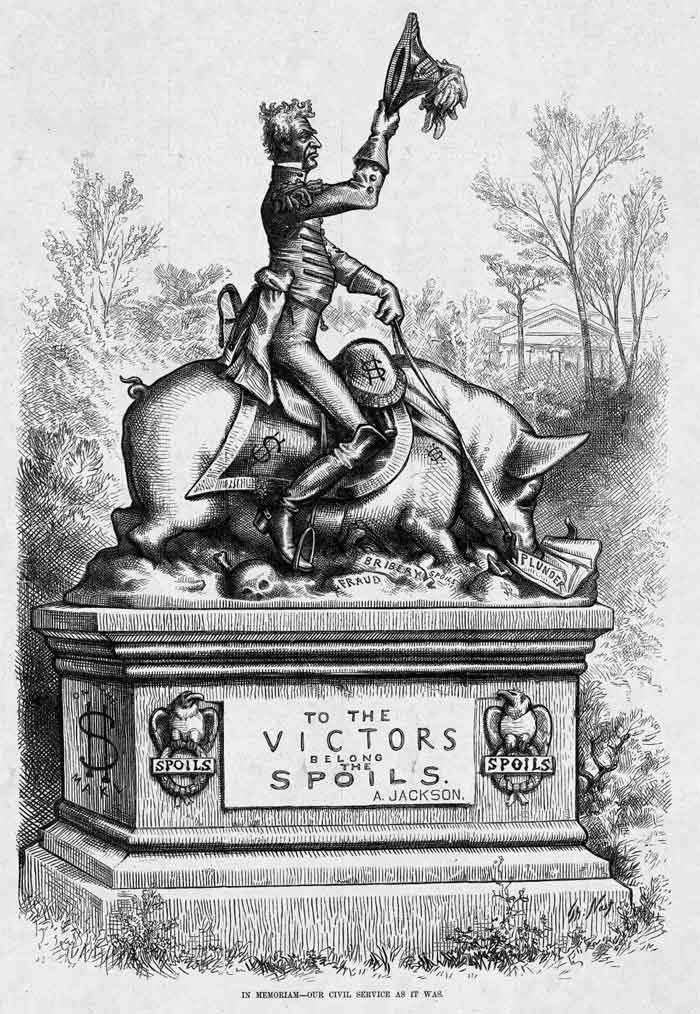
The Trail of Tears was a genocidal plan under the umbrella of Manifest Destiny: a disastrous policy of forcibly attempting to relocate and assimilate 100,000 Cherokee, Choctaw, Chickasaw, Creek, and Seminole from the Southeast. They were entered into a militant and cruel 1,000 mile relocation to territory west of the Mississippi such as Oklahoma.
Jackson’s genocidal platform persisted for at least three decades, one of the worst chapters in American history set in place by one of its worst Presidents.
Some estimates say of 15,000 Cherokee who the U.S. military raided and forced from their homes at gunpoint, approximately one of every three died while being pushed westward.
It would be like sitting down at a large family table and saying look at the person to your left, look at the person to your right, one of you three was just killed on a death march. Speaking of family tables, apparently the U.S. wanted to be both as cruel and efficient as possible so they raided and detained Native American families specifically at dinner time — bayonets and rifles shoving families from their meal into “detention” cells.
While researching the official American maps along the “Trail of Tears” I noticed a very important location in Arkansas that doesn’t get appropriate recognition for a mass grave there.
Even worse, as I searched the area I noticed Arkansas history groups very intentionally downplay national records and deny proper representation for victims of genocide. It’s shocking to find Arkansans who seem both to falsely appropriate Cherokee history as their own lineage, while ignoring or denying actual Cherokee history and even erasing atrocity crimes.
Here’s a snippet from the NPS map, for example of how this plays out, from a “places to go page” that clearly calls out the “Cadron Settlement”.
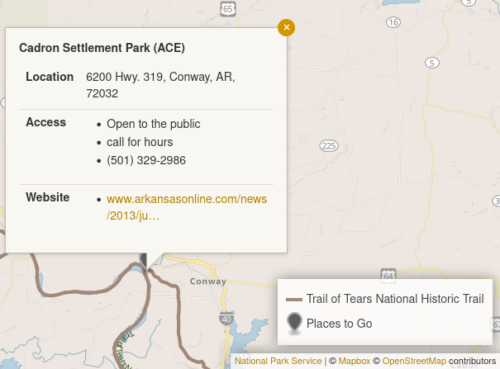
Clicking from the NPS map into the Cadron Settlement (National Historic Site) gives the exact opposite of more information about this history. Here is what we are told by the Arkansas Online article:
Cadron was also the county seat of Conway County from 1825 to 1828. “But by the 1830s, the population began to dwindle, and by 1834, the blockhouse was gone,” she said. “The Historical Society and volunteers built a replica of the blockhouse and dedicated it in 1973, but it burned in the early-1990s, only to be rebuilt a third time in the mid-1990s.
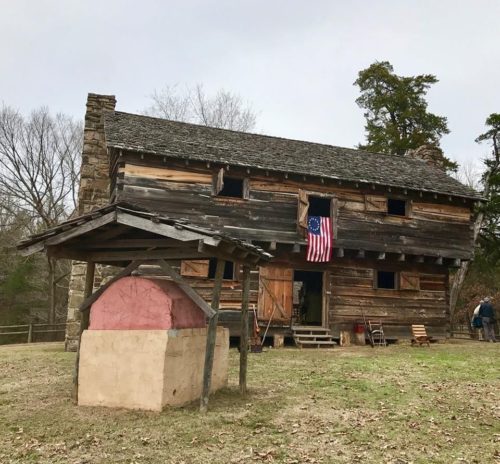
A blockhouse was gone by 1834? Very suspicious timing.
It looks like an unmarked representation of a late 1820s American internment camp (e.g. concentration camp).
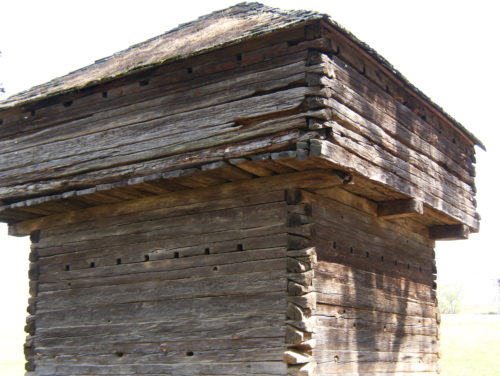
That Arkansas Online article positions the complex history of a wood building on top of a hill very misleadingly as a place white settlers engaged in trade for rapid prosperity, even hinting about a place of survival that protected settlers (from the people they threatened).
Prosperity from trading with Cherokee and other Native Americans near Cadron had by 1820 fueled speculation and a bid to make it the capitol/seat of the entire Arkansa territory. A year later however the legislature abruptly rotated to Little Rock, the next steamboat stop downstream.
Simply put, legislators and investors from Little Rock expected control of new plots there to make them richer than if they invested in Cadron (since Native Americans being systemically exterminated meant a Cadron trade-based economy would likely collapse). They also detested “integrated” aspects of trade-based economics, which clearly allowed non-whites to become prosperous and retain some power or authority in the region.
Although Cadron had risen to prominence as frontier town with even hundreds of muti-racial residents due to its trade routes, by 1812 Andrew Jackson very loudly had warned he quickly could deflate that market (due to forced relocation and genocide of Native Americans). Settlers increasingly trashed markets of Native American cooperation, stole from them instead and militantly sought other sources of rapid enrichment.
The fairly obvious explanation for how and why Cadron’s economy collapsed so abruptly is because of a shift by arriving white speculators towards what an Arkansa territory explorer in 1819 called a search for “high and rich body of alluvial lands” if not a feckless search for actual gold (e.g. the Georgia 1829 rush, sparking the Trail of Tears).
Abandonment of Cadron’s forested hills, trails and steamboat landing — perfectly suited for a trade market — was in this context of get-rich-quick schemes of white men who had no interest in benefits going to anyone but themselves.
Human tragedy under a militant economic shift away from trade routes and to raw land acquisition and wild speculation (Trail of Tears as violent economic platform) was recorded April 15, 1834 in a journal entry of Lt. Joseph W. Harris (cited in a 1957 history journal) as he observed hundreds of displaced Cherokee under his command quickly dying in Cadron.
Already weakened by measles, poor diet, and other conditions occasioned by their removal, the Cherokees died in droves. Graves scattered through what is now Dedar Park, originally part of the town of Cadron, and here and there on the adjacent hillsides, are believed by some to be graves of these Cherokees. They are marked with headstones and footstones of native rock. There can be no doubt that their camping place was at the old townsite, but with the advent of cholera, the Indians spread out through the woods to avoid contagion. Harris probably referred to the abandoned town when he wrote: “My blood chills even as I write, at the remembrance of the scenes I have gone through today. In the cluster of cedars above the bluff which looks down upon the Creek & river, and near a few tall chimneys — the wreck of a once comfortable tenement, the destroyer has been most busily at work, three large families of the poor class are there encamped…”
Mass death in the “abandoned” plots of Cadron, given how it formerly been a boom town for trade with the Native Americans, thus can not be denied as an important memorial site to the barbarity of their treatment.
That phrase “conditions occasioned by their removal” is even better explained in a 1989 Georgia Historical Quarterly article.
At the time of sailing, an effort was made to get [Cherokee] consent to go into the boats, but not an individual would agree. The agent then struck a line through the camp, the soldiers rushed in and drove the devoted victims into those loathsome receptacles of disease and death. It is said by eye witnesses that the scene of this distress was agonizing in the extreme.
It should not be any wonder why so many Cherokee perished when their “loathsome receptacle of disease and death” landed on the banks of Cadron.
So what does a blockhouse there really represent?
It symbolizes internment camps and death, given how “Order 34” was based on a network of blockhouses built for facilitating genocide.
Order 34 was brief and equivocal. It stated: “The commanding officer at every fort and open station will first cause to be surrounded and brought in as many Indians, the nearest to his fort or station, as he may think he can secure at once…” [and thus] stockade forts [such as blockhouses] were erected for gathering and holding the Indians preparatory to removal. …a colonel in the Confederate army said of the debacle: “I fought through the Civil War and have seen men shot to pieces and slaughtered by the thousands, but the Cherokee removal was the cruelest work I ever knew.” Another veteran expressed a similar view: “During the Civil War I watched as hundreds of men died, including my own brother, but none of that compares to what we did to the Cherokee Indians.”
The reason for memorializing such a blockhouse as a sign of settler prosperity (eerily symbolic of a militant detention and mass death) as more important to the Cadron park stewards than memorializing the systemic extermination of Native Americans is presumably simple.
The white settler view that dominates local history of Cadron very intentionally obscures mass graves there let alone President Jackson’s genocidal legacy.
The park formally became a National Register of Historic Places in 1974 such that by 1976 the Faulkner County Historical Society, Conway Chamber of Commerce and the Army Corps of Engineers built the large replica blockhouse fort as their center-piece.
It wasn’t until around 1989 that these groups allegedly started to acknowledge or reveal the mass deaths that such a blockhouse represented.
In 1991, a cemetery census by the Faulkner County Historical Society identified forty-four Indian graves and thirty-six unidentifiable graves, but there may have been many more unmarked graves.
May have been many more graves?
It’s strangely vague given the magnitude of the deaths relative to the populations at that time. Let me reiterate that the following paragraph is all I could find in that Arkansas Online article about the Trail of Tears, despite it being the “official” source on the NPS map encouraging people to learn more about the Trail of Tears.
Cadron Settlement also was on the Trail of Tears and a stopping spot for the Butterfield Overland Mail Route. Interpretative signage about both events and markers are on display at the park. Both the Trail of Tears and the Butterfield Trail are part of the Arkansas Historic Trails System. […] The park features a boat-launching ramp, hiking trails, restrooms, picnic areas, a pavilion and handicapped trails and parking areas.
We are told markers are on display. Where are they? What do they say relative to blockhouse settler narrative?
Not only is Arkansas’ prominent role in the Trail of Tears a tiny afterthought that barely gets any mention in the NPS-linked article about the site, it’s served up only alongside a mail route as if it can’t be handled directly.
Who really cares about the Butterfield Overland Mail Route, for example? This two-year mail route isn’t even yet considered a national trail system, as it’s not officially recognized by NPS. Why is such an important and solemn site getting lumped in with a momentary curiosity such as a mail route?
More to the point, an obscure mail route really doesn’t belong in the same paragraph as the systemic government policy of genocide.
The removal was systematic, and contributed to the large loss of life of Native Americans. The Trail of Tears constitutes a genocide because it was deliberate in its removal, targeted a specific population, and led to the death of thousands of Native Americans.
It’s almost like if you were to bring up the Trail of Tears some local historian or park custodian would awkwardly and immediately change the subject to the Butterfield.
Indeed, Arkansas Online in a “settlement remembered” article admits the important Trail of Tears details have been made hard to find. It even opens with a photo of the inane wood cabin instead of a genocide memorial.
Tucked at ground level, the memorial can be searched out at Cadron Settlement Park…
Searched out. The memorial can be searched out.
Not where to look, not what to look for or how it appears, just that a memorial to genocide “can be” found if someone were to try hard enough. It’s as if meant to be forgotten or lost.
The Arkansas Online article goes on to describe a completely underwhelming “memorial” being just a small plaque cemented flat on the ground in some bushes.
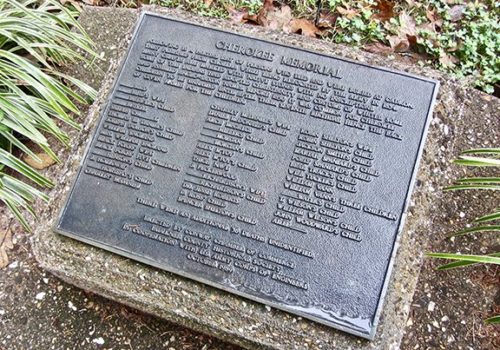
The memorial choice of words is not great, either.
…a crowded vessel carrying some 700 Cherokees en route to exile in what later became Oklahoma had to dock here due to low water on the Arkansas River. The cholera that spread among the stranded passengers claimed 100 or more lives. […] Thirty of the list’s 50 victims were children, hardly any with listed identities. The inscription explains that “before 1850, it was common for Cherokee children to be unnamed until their seventh birthday.”
Let’s start with the end of this unfortunate text.
It’s hard to square the apologetic-sounding comment on the plaque that a Cherokee tradition was to have unnamed children.
Not only does such a claim sound logistically absurd (parents obviously had ways to connect precisely with their children), it doesn’t stand up to even basic history let alone anthropology.
A Cherokee Dictionary, for example, puts such a claim to shame very simply.
By tradition, an older woman of a Cherokee clan gives a child a name at birth. The name is a clan name, passed along within the clan. In earlier times, that name was kept a secret, and the child grew up with a nickname. A boy was often simply called “Boy” or “Choogie,” from the word for “boy,” achuja.
A given birth name was a Cherokee tradition.
This is the exact opposite of that “memorial” trying to make a lame excuse about children being unnamed. American soldiers literally kidnapping Cherokee children and forcing them at gunpoint into internment blockhouses is a more factual explanation for them being unnamed.
Moreover, regularly calling a child “boy” or “princess” is very common across cultures. It’s like saying “come here princess” to a girl, which does not in any way mean any child is unnamed or some kind of mythical princess.
The very likely reason genocide victims had their names missing on this plaque (and one it obviously isn’t ready to admit) is related to oppressor habits of dehumanizing targets via erasure tactics. Any attempted claims that Cherokee record-keeping had gaps are very highly suspect for two important reasons.
First, Cherokee people have some of the most documented lineage of anyone and there always is extensive record keeping inherent to systemic race-based genocide.
In the lead-up to the Trail of Tears, the documentation of Cherokees was extensive and exhaustive. Censuses were conducted, heads were counted, names were recorded, birth and marriage and death were noted — bureaucracy was part of the Indian management and removal process.
Second, the obfuscation of records on this site is a tell-tale sign of data integrity attacks for purposes of appropriation and erasure.
…claiming a royal Cherokee ancestor, white Southerners were legitimating the antiquity of their native-born status as sons or daughters of the South, as well as establishing their determination to defend their rights against an aggressive federal government, as they imagined the Cherokees had done. These may have been self-serving historical delusions, but they have proven to be enduring. The continuing popularity of claiming “Cherokee blood” and the ease with which millions of Americans inhabit a Cherokee identity speaks volumes about the enduring legacy of American colonialism. Shifting one’s identity to claim ownership of an imagined Cherokee past is at once a way to authenticate your American-ness and absolve yourself of complicity in the crimes Americans committed against the tribe across history.
Thus, Arkansas historians and park managers are failing on multiple levels.
Imagine a holocaust memorial such as Auschwitz setup to tell visitors “this is where women milled wheat and sewed dresses for decades, at one point it also had a death camp and a post office on a mail route. The dead here sometimes didn’t have names, just numbers, so unmarked graves are all around for you to have a picnic on or hike through and make it a fun day to forget genocide.”
It’s shocking to think about the more than 100 victims on or around the hilltop in Cadron who remain nameless and unmarked in a mass grave as the very spot caretakers today assign to gleeful picnics and parties.
Locals seem to have focused all their energy and money on an overbuilt wood house that emphasizes mostly the “protecting the white woman” narrative, with little to nothing setup to recognize all the surrounding tragedy.
TripAdvisor even ranks visiting the large unmarked mass grave as the #1 thing to do in this area of Arkansas. And yet many of its reviews emphasize there isn’t much to see or do there!
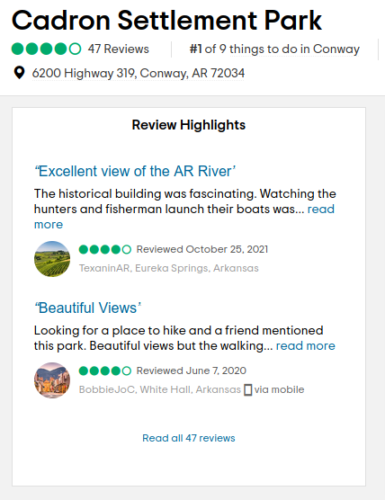
It really makes no sense for an important spot on the Trail of Tears to have a small hidden marker that nobody is meant to see in the shadows of an overblown fantasy “pioneer” celebration format that nobody really should want to attend.
Arkansas also has a history of very heavily-funded sympathetic yet infamous politicians pulling odd tone-deaf publicity stunts like this one:
President Clinton waves to the crowd as he boards the 2,000,000th Jeep Cherokee after it was rolled off the assembly line at the Toledo Jeep/Chrysler Assembly Plant Tuesday Aug. 27, 1996…
I don’t think I could say it any better than a Business Insider article on why Jeep has been doing the obvious wrong thing on this subject since 1974.
“The best way to honor us is to learn about our sovereign government, our role in this country, our history, culture, and language and have meaningful dialogue with federally recognized tribes on cultural appropriateness,” Hoskin said in response to the outlet’s request for comment on the upcoming Jeep. […] Using Native mascots is “detrimental Native people,” according to a study conducted by the University of Michigan and coauthored by Arianne Eason, an assistant professor of psychology at UC Berkeley. She said the mascots “decrease Native individuals’ self-esteem, community worth and achievement-related aspirations.”
Developing the Cadron Settlement on the Trail of Tears into a large memorial center (given how central it is to the Trail) with an appropriately prominent marker would transform this area almost immediately into an actual destination spot that properly honored those who suffered. It could even have a genocide library of sorts to help with the looming question of Cherokee identity and the direct harm of appropriation tactics. And I know there are some politicians and major American corporations who are long overdue for giving any proper respect to the Cherokee.
Wado.
Two of my relatives are on that tiny marker, William England and his wife, Susannah vs. “Mrs. England.
I came across this https://www.youtube.com/watch?v=ygZjo9ehekU and the “memorial area” walked over by a landscape photographer that titled their video Cadron Trail of Tears. The person and many who posted don’t have any interest. As you can see. However, watching the video and the image of the river, water levels would have been slightly different, it was sobering. Not sure I’ll ever get to go there, so for that, I’m glad to see a video here and there of places my family walked and ultimately, I’m here and my descent to share our history.
I completely agree with your comparison to the German death camps. In fact, I will be using this in one of my assignments. Love your passion, don’t stop speaking. Our stories haven’t been told yet. What is, not accurate or sugar coated to make people comfortable. Silence and ignorance doesn’t change things. Very glad to see this online.
Yesterday, after more than 25 years, my wife and I revisited the Cadron Settlement Park. It looked much the same as it did in 1996 but with with one glaring difference-the absence of the gravestones!
Back then (crowded inside the circular sidewalk atop the small rise directly in front of the “block house “) there was a collection of mostly native sandstone grave markers. Some were carved and many were not. Obviously something happened here and it was sobering to look at.
Fast forward to 2023 and I wonder what happened to the grave markers? Is the evidence of genocide being erased?
Upon our return home I immediately did a quick internet search but was unable to find the answers.
The flyingpenguin.com posting I just read comes the closest to the answers but only alludes to what probably actually happened (Connecting the dots, I have concluded that the gravestones were probably removed in order to protect them from vandalism.)
After all, Arkansas is infamous for its racism, which indeed is best exemplified by its past treatment of the black population; Remember Gov. Orval Faubus and his refusal to allow black children to attend Little Rock High School? It could be argued that Arkansas still carries a “black” eye (no pun intended) from that single racial incident alone. One need only google the words “Arkansas racism” and the whole national scandal pops up.
As pointed out in the above posting about another shameful/racial national scandal, The Trail of Tears, it shows that this particular Arkansas connection is not nearly so well known. It also points out the little-known fact that Arkansas previously had its own forced Cherokee relocation out of the western part of the state! (I’ve often wondered why there are places in the Ozark’s with “Cherokee “ in their names.)
There are many descendants of Indians living in Arkansas today, but we (and our history) are all but invisible when compared to that of the black race.
As an Arkansas native son and a Cherokee/Choctaw descendant, there is much that I could say about past racism against the Indians, the taking of their lands and racial genocide. This article speaks exhaustively on these subjects and points a sharp stick at the perpetrators of those crimes! There is little that I could add about this sad history.
I think a few observations, however, are still relevant.
Unlike the political climate in 1830, the winds in 2023 blow much more favorably with sympathy towards the blacks than they ever have with the Indians. They blow especially hard against Indians (like the Cherokees) that once held black slaves! (Ouch!)
As poignant as the retelling of the old atrocities committed during The Trial of Tears are , they are mostly now buried in the relatively distant past and lack todays emotions found in the voices of an entire formally enslaved black race.
You (us) white people, when you look at me, you don’t say “there stands an Indian”. Instead you say “ you look more-or-less like me”. Where is your racism now? Where would your sympathies instead lay if you clearly saw a “black” person standing there?
I (and many others as well) believe that in this country all races will someday be assimilated into one “American culture”. This process will require a collective amnesia about “all” the past “atrocities “ our government (and people) have committed. I also believe that (to this end) an education policy seems to have been adopted by our public schools in how they are now teaching history. Anyone want to take history class field trip to Cadron Settlement Park?
Thomas Bain
Pocola, Oklahoma
So much information — much of it “cherry” — and I appreciate it. There is a story to be told and I’m glad someone is actually stirring it up and sharing it with others. We should never forget!